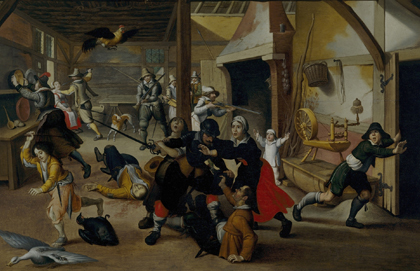Sixteenth-century Christian Europe had a pluralism problem. In the wake of the Reformation, Catholics persecuted Lutherans, and Lutherans persecuted Catholics. Calvinists and Lutherans harassed each other; and in Britain, Catholics, Anglicans and Presbyterians each found themselves in the position of oppressor and oppressed at different times. Throughout Europe, Anabaptists – who had no territory or prince of their own – came under vicious attack. Religious minorities who refused to conform to the beliefs or observances established by the authorities could be killed, tortured or driven from their homes.
Even more destructive than this local persecution was the large-scale, organized violence that we have come to know as the Wars of Religion. In these wars, states either took up arms against other states in the cause of this or that Christian group or were themselves torn apart by civil war between confessional factions. The largest of these wars included the French Wars of Religion (1562-1598), a period of civil strife primarily pitting Catholics against Huguenots; the massive Thirty Years’ War (1618- 1648), which expanded from a war between rivals within the Holy Roman Empire to draw in France, Sweden and other combatants; and the Wars of the Three Kingdoms (1639-1651) in the British Isles, which were in part provoked by the religious policies of James I and Charles I. From 16th century Bohemia to 17th century Ulster, Christian hands shed Christian blood in the name of Christ.
This outpouring of violence cries out for interpretation, particularly by those of us who are Christians and are horrified by the bloody actions of our forebears. Who or what is to blame? More importantly, what lessons can be drawn so that such events are never repeated? In what follows, I explain the problems with two common “readings” of the Wars of Religion before suggesting a better way of thinking about the problem of religion and pluralism.
One reading blames the Reformation for the violence of the Wars of Religion. If only the reformers had been more patient or less obstinate, or if only the ecclesiastical authorities had been more willing to compromise, or if only the Catholics (or the Protestants) had realized the error of their ways and embraced the Protestant (or Catholic) truth, the tragic division of the corpus Christianum could have been averted and no violence would have ensued. On one level, this argument makes sense: If there were no Catholic-Protestant distinctions, logically Catholics and Protestants would not have killed each other for being Catholics or Protestants.
This reading, however, ultimately boils down to “if everyone agreed with each other, there would be no conflicts.” It is true, but not particularly helpful for dealing with a real world in which disagreements exist. Looking deeper, then, we see that the problem that needs to be grappled with in understanding the religious violence of the 16th century is not the existence of theological disagreements but the inability of Christian society to peacefully countenance those disagreements. Once we frame the issue in that way, it quickly becomes apparent that the problem was much older and more deeply rooted than the Reformation. Consider the widespread use of violence by Christian authorities against professed Christians deemed heretical in the Middle Ages, such as Waldensians and Hussites. Even more so, consider the use of violence by Christian authorities against non-Christians: Charlemagne’s forcible conversion of the pagan Saxons in the eighth century, the infamous crusades in the Holy Land, the Teutonic Knights’ campaigns against the pagan Lithuanians in the 13th century, and the recurring massacres, expulsions and forced conversions of Jews. In what kind of Christian society could auto-da-fé, meaning “act of In our secular age, a more common reading of the Wars of Religion runs something like this: After the Reformation, religious passions ran amok and led to great bloodshed, until finally political authorities banished religious disputes from the public realm, and established the religiously neutral, secular State as a bulwark against irrational extremism. With religion confined to its proper place in the private sphere, order and tolerance for all was assured. The lesson is that religion is a particularly divisive and dangerous aspect of human life that needs to be kept separate from “secular” aspects of life and society. This account immediately strikes late modern Western ears as having the ring of truth, in part because we imbibed it with our mothers’ milk: A version of this reading can be found in the most influential thinkers who constructed the modern political imagination, from Hobbes to Voltaire to Rawls. In fact, in his powerfully argued book, The Myth of Religious Violence, William Cavanaugh calls it the “creation myth” of the modern West.
The problem, as Cavanaugh painstakingly demonstrates, is that nearly every piece of this account breaks down upon closer examination.
First, a closer look at the so-called Wars of Religion reveals that the opposing sides in these wars could rarely be neatly divided along religious lines. Just to give a few examples, the opening decades of the Reformation saw Catholic France allying with the Muslim Ottoman Empire against the Catholic Holy Roman Emperor Charles V, who in the same period went to war against the pope and had his forces sack Rome. Similarly, in the French Wars of Religion, it turns out that Catholic and Protestant peasants united against the nobility, and Catholic and Protestant nobles joined forces against the crown. The Thirty Years’ War may have begun with a league of Protestant princes fighting a Catholic emperor, but Catholic France soon entered the war on the side of Protestant princes and against the Catholic Habsburgs, with the result that the second half of this most destructive of early modern religious wars was dominated by fighting between Catholic states. Pope Urban VIII, concerned to prevent the growth of Habsburg power, himself blessed the alliance between France and Protestant Sweden against the emperor. At a minimum, then, it is misleading to think of these wars as being driven or defined by theological disagreements.
A second problem with this narrative concerns its benign view of the role of the State, which supposedly stepped in to save Europe from religious violence. In fact, Cavanaugh shows, most of the violence was either perpetrated by emerging monarchical states as part of a long-term trend of aggressive centralization that had begun well before the Reformation, or amounted to resistance to those trends by princes, nobles or commoners. The English Civil War, for example, was just as much about the conflict between an aspiring absolutist monarch and Parliament as it was about episcopacy or kneeling during communion. The initial conflicts in the Thirty Years’ War were as much about the efforts of German princes to resist the growth of imperial power as they were about Protestant-Catholic tensions. Rather than seeing the State as the solution to the Wars of Religion, it is far more accurate to see competing State-building projects as a central cause of those wars.
Third, the narrative of states coming to the rescue of public order by banishing religion to the private sphere overlooks the fact that most of the States of the 16th and 17th century did no such thing. To the contrary, from England to France to Austria to Sweden, these absolutist states wherever possible forced confessional conformity on their subjects and turned territorial churches into instruments of State policy. The purportedly religiously neutral secular State did not emerge in most of Europe until the 19th century, much too late to have been the solution to the religious warfare of the 16th and 17th centuries.
Fourth, and most fundamentally, Cavanaugh argues that the very notion of religion as a distinct, particularly violence-prone area of life that can be separated from secular areas such as politics and economics is an invention of early modern Europe, rather than a universally valid category. While this notion of religion is part and parcel of our way of thinking about the world, Cavanaugh and others have amassed striking evidence that the concept simply did not exist outside Europe before the arrival of Europeans, nor was it found in ancient or medieval Europe. Indeed, neither ancient Latin nor ancient Greek nor major non-European languages had a word with the same meaning as our modern word religion. In fact, most of what we call religion today was historically much more than a private search for salvation and ultimate meaning; it was intimately concerned with aligning the social order – including the State – with the cosmic order. The invention of the category of religion in early modern Europe – as something that needed to be restrained by the State and kept out of the secular realm – actually served the interests of State-builders who wanted to control the churches and neutralize any potential theological challenges to their absolute authority. Later, it also provided ideological cover for the sacralisation of the State and its values, and shifted attention away from the modern State’s own pervasive use of violence in the name of those values.
The image of a bloody era of religious wars ended by the rise of the peace-loving State quickly turns to nonsense when we think of the wars of Louis XIV, or the French Revolution, or the 19th century apogees of imperialism and nationalism, or the bloodbaths of the first half of the 20th century perpetrated by fascist, communist and liberal states.
Our very categories for thinking about the violence of the post-Reformation period, therefore, include power-laden assumptions that obscure as much as they reveal.
If these readings of the Wars of Religion are misleading, then, how should we read this bloody era? A better reading, I would argue, begins with the recognition of two important realities. First, all societies contain some degree of what might be called confessional diversity, that is, disagreement about things of ultimate importance such as the purpose of human life, the relationship of society to a larger cosmic order, the legitimate aims of collective institutions, and so on. Even if relative confessional homogeneity exists in some place at some time, it does not last for long. Second, there is no such thing as a “religiously neutral” State; all states, including purportedly secular ones, derive their legitimacy from and make decisions with reference to some set of sacred values and some kind of moral order. Even in liberal states, that moral order sets boundaries for the expression of rival values, boundaries that are backed by coercive power.
Rogue polygamists, would-be practitioners of sharia, or Christian organizations attempting to enforce certain kinds of codes of conduct for employees, for example, can all attest that the early 21st century liberal Canadian State sets firm limits to the expression of rival moral orders, especially where the core value of individual autonomy is at stake. Contemporary Canada is more like the Ottoman Empire – where Christian and Jewish subjects were afforded a degree of freedom within constraints established by the overarching framework of Islamic and dynastic law – than we usually admit.
In light of these two realities, then – the existence of confessional diversity and the impossibility of a value-neutral State – the question we must face is this: What kind of moral order can create the best space for peaceful pluralism, domestically and internationally? Now it is clear that much of Christianity’s track record in this regard is rather dismal. We can rightly conclude from the Wars of Religion and their antecedents that the Christian political order of the medieval and Reformation eras failed, catastrophically, to peacefully accommodate confessional diversity.
We must acknowledge that the modern liberal State, on the whole, has often done a better job of this. At the same time, it has also struggled to accommodate certain kinds of confessional diversity, and has sometimes taken on an almost totalitarian aspect in restraining rival moral orders; one thinks, for example, of Bismarck’s Kulturkampf supported by German liberals, or French anticlerical schooling reforms in the 19th century, both intended to domesticate an insufficiently co-operative Catholicism. States professing liberal principles have also engaged in their share of military and colonial violence against the Muslim or non-white or socialist other around the world in the past two centuries – sometimes in the name of those very principles. On the other side of the ledger, at least some of the positive accomplishments of liberalism owe something to Christian influences. In the English-speaking world, for centuries the emergence of liberal principles was advanced by the convictions of certain strains of Protestantism. The establishment, at long last, of a popular liberal political culture in Germany after 1945 rested to a large degree on the appeal of a Christian Democratic movement rooted in Rhineland Catholicism.
What, then, can those of us who are Christians have to offer to the conversation? If liberalism is both less adept at handling pluralism and less purely “secular” than often supposed, it suggests the possibility of a religious contribution to the effort of accommodating pluralism, including contributions from Christians. Moreover, as I have argued before in these pages, the secular order is shakier than it seems, and we will eventually need alternatives. It is essential that we avoid the mistakes of the past – the medieval alliance between sword and mitre and early modern absolutism have little to offer us as models – but there are other streams within the Christian past that can furnish values for genuine coexistence. Late modern Christians will need to acquaint themselves with them if we hope to offer a defence of pluralism that is rooted in, rather than predicated on, an abandonment of our own deepest beliefs.
We catch occasional glimpses of this “road not taken” already in ancient and medieval Christianity. Peter Leithart argues, for example, that even Constantine himself, with all of his offences against pluralism, had a vision of a Christian commonwealth that could encompass toleration of Jews and pagans. Several medieval popes, beginning with Callixtus II and his 12th century bull Sicut Judaeis, attempted to protect European Jews by prohibiting Christians from harming them, taking their property, disrupting their festivals or forcing them to convert.
Later, in the early modern and modern periods, full- bodied Christian defences of pluralism emerged. From the time of the Reformation, continental Anabaptists, for example, rejected on Biblical grounds any use of violence on behalf of the Church. English Baptists developed a strong Biblical rationale for the institutional separation of Church and State and freedom of conscience in the 17th century. More recently, in the continental Reformed tradition, the Dutch statesman Abraham Kuyper and his followers introduced concepts such as sphere sovereignty that provided a principled basis for both institutional pluralism and co-operation in the political sphere across confessional lines. Parallel movements emerged in Catholicism, especially in the 20th century. Such Catholic thinkers as Jacques Maritain, for example, worked out a theologically grounded notion of personal dignity and human rights, including freedom of conscience, which bore fruit in the Christian Democratic political movements of the post-war period and was embraced by the Church in the Second Vatican Council’s declaration Dignitatis humanae (1965). These heritages from a range of Christian traditions provide resources for a principled defence of pluralism and a repudiation of religious persecution and violence.
To be sure, we must never forget the bloodshed in the history of Christianity, including the violence of the post-Reformation period. Seeing this violence clearly, however, also means correcting misreadings that blame the violence on the Reformation, or a peculiar religious tendency toward violence, while overlooking the violence of the State. Instead, if we recognize that confessional diversity is a fact of life, and that a religiously neutral, value-free State is impossible, we more clearly see our responsibility to advocate public values rooted in our own traditions that can protect pluralism. Those of us who are Christians have a particular responsibility to articulate an alternative Christian vision that renounces violence in favour of a robust, principled defence of confessional pluralism, peaceful coexistence, and freedom of conscience and worship for all.





